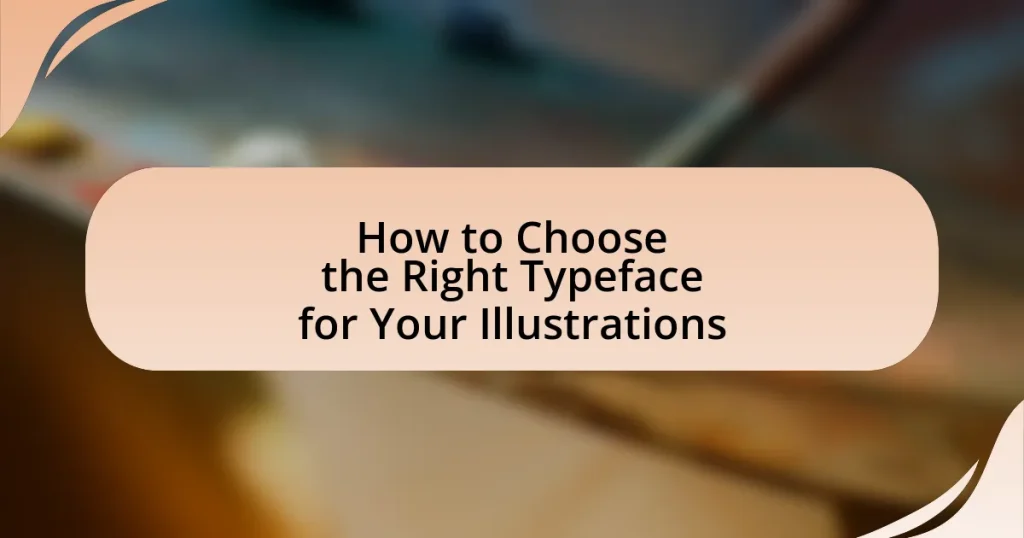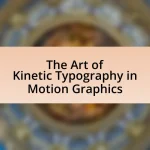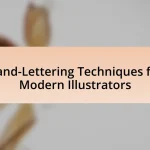Choosing the right typeface for illustrations is essential for effective visual communication, as it impacts legibility, style, and context. Key factors to consider include the purpose of the illustration, audience demographics, and the emotional tone conveyed by different typeface categories such as serif, sans-serif, and decorative fonts. The article outlines best practices for ensuring readability, avoiding common mistakes, and utilizing tools for typeface selection and pairing. Additionally, it emphasizes the importance of testing typefaces through mockups and gathering audience feedback to enhance the overall effectiveness of the design.
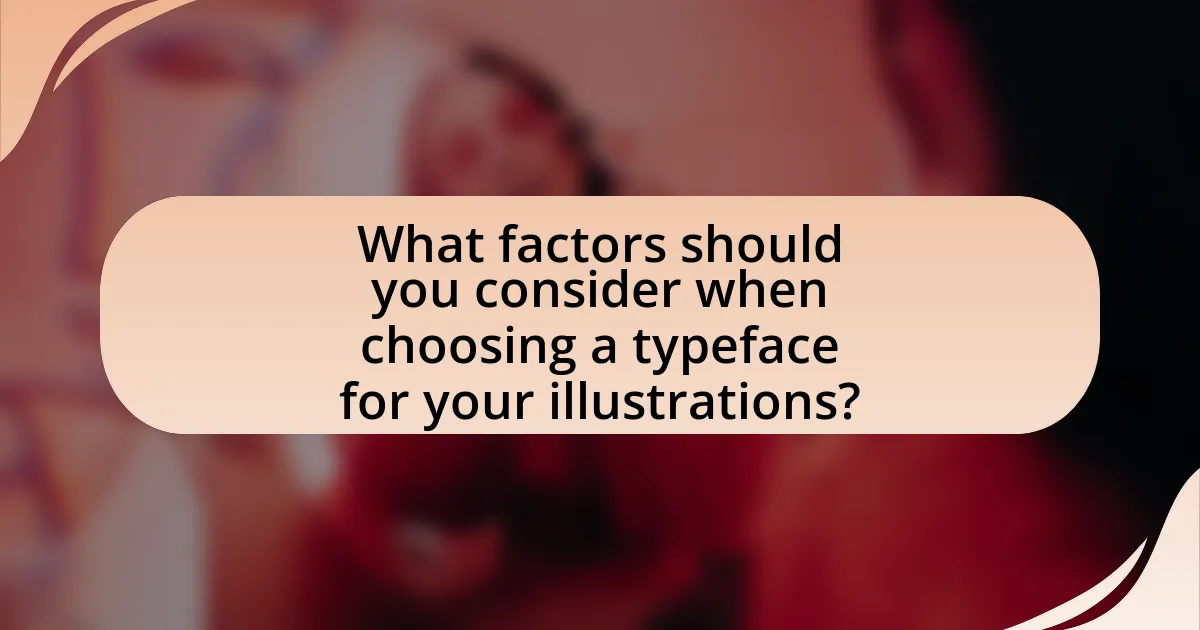
What factors should you consider when choosing a typeface for your illustrations?
When choosing a typeface for your illustrations, consider legibility, style, and context. Legibility ensures that the text is easily readable at various sizes and distances, which is crucial for effective communication. The style of the typeface should align with the overall aesthetic of the illustration, whether it is playful, formal, or minimalist, to create a cohesive visual experience. Context involves understanding the audience and purpose of the illustration; for instance, a typeface suitable for a children’s book may differ significantly from one used in a corporate report. These factors collectively influence the effectiveness and appropriateness of the typeface in enhancing the illustration’s message.
How does the purpose of your illustration influence typeface selection?
The purpose of an illustration significantly influences typeface selection by determining the emotional tone and readability required for effective communication. For instance, a playful illustration aimed at children may utilize a rounded, whimsical typeface to enhance engagement, while a formal illustration for a corporate report would benefit from a clean, sans-serif typeface to convey professionalism. Research indicates that typefaces can evoke specific emotional responses; for example, studies show that serif fonts are often perceived as more trustworthy, while sans-serif fonts are viewed as modern and approachable. Therefore, aligning the typeface with the illustration’s purpose ensures that the visual message is coherent and impactful.
What types of illustrations require specific typefaces?
Illustrations that require specific typefaces include branding illustrations, editorial illustrations, and infographics. Branding illustrations necessitate typefaces that align with a brand’s identity, ensuring consistency and recognition; for example, Coca-Cola uses a distinct script typeface that reflects its heritage. Editorial illustrations often utilize typefaces that enhance readability and complement the article’s tone, such as serif fonts in traditional publications. Infographics require typefaces that are clear and legible at various sizes, often using sans-serif fonts for modern appeal. These requirements are supported by design principles emphasizing the importance of typography in visual communication, as seen in studies highlighting the impact of typeface choice on audience perception and engagement.
How can the message of your illustration guide your typeface choice?
The message of your illustration can significantly guide your typeface choice by ensuring that the typography complements and enhances the visual narrative. For instance, a playful illustration may benefit from a rounded, whimsical typeface to maintain a lighthearted tone, while a serious or formal illustration might require a clean, sans-serif typeface to convey professionalism. Research indicates that typefaces can evoke specific emotions; for example, studies show that serif fonts are often perceived as more trustworthy and traditional, while sans-serif fonts are viewed as modern and approachable. Therefore, aligning the typeface with the illustration’s message ensures cohesive communication and enhances the overall impact of the design.
What role does readability play in typeface selection for illustrations?
Readability is crucial in typeface selection for illustrations as it directly affects how easily the audience can comprehend the text. A typeface that enhances readability ensures that the message is conveyed clearly and effectively, which is essential in visual communication. Research indicates that typefaces with higher x-heights, wider letter spacing, and clear distinctions between similar characters improve readability, making them more suitable for illustrations. For instance, studies have shown that sans-serif fonts like Arial and Helvetica are often preferred for their legibility in various sizes and contexts, particularly in digital formats. Thus, prioritizing readability in typeface selection significantly enhances the overall effectiveness of illustrations.
How does font size affect readability in illustrations?
Font size significantly affects readability in illustrations by determining how easily text can be perceived and understood by viewers. Larger font sizes enhance visibility and comprehension, especially from a distance, while smaller font sizes may lead to strain and misinterpretation. Research indicates that text should be at least 12 points for optimal readability in printed materials, and larger sizes are recommended for digital displays to accommodate varying screen resolutions and viewing distances. Studies show that a font size of 16 points or larger is often preferred for online content, as it improves legibility and user engagement.
What are the best practices for ensuring readability in various contexts?
The best practices for ensuring readability in various contexts include selecting appropriate typefaces, maintaining adequate contrast, and using clear hierarchy. Appropriate typefaces, such as sans-serif fonts for digital screens and serif fonts for print, enhance legibility. Maintaining a contrast ratio of at least 4.5:1 between text and background improves visibility, as recommended by the Web Content Accessibility Guidelines (WCAG). Establishing a clear hierarchy through font size, weight, and spacing helps guide the reader’s eye, making the content easier to navigate. These practices are supported by research indicating that readability significantly impacts user engagement and comprehension.
How do different typeface categories impact your illustrations?
Different typeface categories significantly impact illustrations by influencing the overall tone, readability, and emotional response of the viewer. For instance, serif typefaces convey tradition and reliability, making them suitable for formal illustrations, while sans-serif typefaces offer a modern and clean aesthetic, ideal for contemporary designs. Additionally, decorative typefaces can evoke specific themes or moods, enhancing the narrative of the illustration. Research indicates that typeface choice can affect perception; a study published in the journal “Psychological Science” found that fonts with higher readability improve comprehension and retention, underscoring the importance of selecting the appropriate typeface category to align with the intended message of the illustration.
What are the characteristics of serif, sans-serif, and script typefaces?
Serif typefaces are characterized by small lines or decorative strokes at the ends of their letters, which enhance readability in printed text. Common examples include Times New Roman and Georgia, often used in formal documents and print media due to their traditional appearance. Sans-serif typefaces lack these embellishments, resulting in a cleaner and more modern look, making them ideal for digital screens; examples include Arial and Helvetica. Script typefaces mimic cursive handwriting, featuring fluid and connected letters, which convey elegance and creativity; they are often used in invitations and decorative contexts. Each typeface category serves distinct purposes based on visual style and readability, influencing the overall tone of the illustrations they accompany.
When should you use decorative typefaces in your illustrations?
Use decorative typefaces in your illustrations when you want to evoke a specific mood or theme that aligns with the visual narrative. Decorative typefaces are effective in creating a distinctive personality for the design, making them suitable for projects like invitations, posters, or branding that require a unique aesthetic. For instance, a whimsical typeface can enhance a playful illustration, while an ornate typeface can add elegance to a formal design. Research indicates that typefaces can significantly influence perception; a study by the University of Reading found that typeface style affects emotional responses, reinforcing the idea that decorative typefaces can enhance the intended message of the illustration.
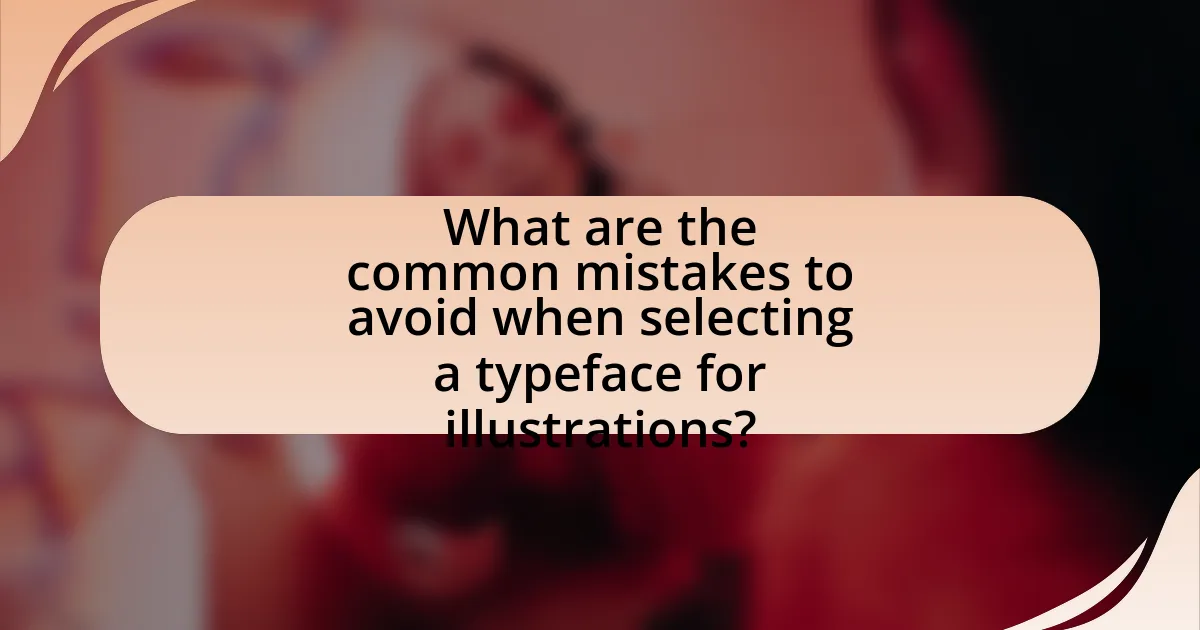
What are the common mistakes to avoid when selecting a typeface for illustrations?
Common mistakes to avoid when selecting a typeface for illustrations include choosing a font that lacks readability, using overly decorative typefaces that distract from the message, and failing to consider the context of the illustration. Readability is crucial; for instance, a study by the International Journal of Human-Computer Interaction found that sans-serif fonts are generally easier to read in digital formats. Overly decorative fonts can overwhelm the viewer, making it difficult to convey the intended message effectively. Additionally, ignoring the context can lead to mismatched aesthetics; for example, a playful font may not suit a serious topic, which can confuse the audience.
How can clashing typefaces detract from your illustration?
Clashing typefaces can detract from your illustration by creating visual discord that distracts the viewer. When multiple typefaces are used that do not complement each other, they can lead to confusion and reduce the overall effectiveness of the design. Research indicates that harmonious typography enhances readability and aesthetic appeal, while conflicting styles can overwhelm the audience and obscure the intended message. For example, a study by the American Institute of Graphic Arts found that consistent typography improves user engagement by up to 30%, highlighting the importance of cohesive typeface selection in illustrations.
What are the signs of incompatible typeface combinations?
Incompatible typeface combinations exhibit several signs, including visual discordance, lack of hierarchy, and readability issues. Visual discordance occurs when typefaces clash in style, such as pairing a serif font with a highly decorative script, leading to an unbalanced appearance. Lack of hierarchy is evident when different typefaces do not effectively differentiate headings from body text, causing confusion in the content structure. Readability issues arise when contrasting typefaces create difficulty in reading, particularly if one font is overly ornate or the sizes are mismatched. These signs indicate that the typefaces do not complement each other, which can detract from the overall effectiveness of the design.
How can you test typeface combinations before finalizing your choice?
To test typeface combinations before finalizing your choice, utilize design software or online tools that allow you to visualize different pairings in real-time. These platforms, such as Adobe Illustrator or Google Fonts, enable you to input sample text and adjust font sizes, weights, and styles to see how they interact. Research indicates that visualizing typeface combinations helps in assessing readability and aesthetic harmony, which are crucial for effective design. By experimenting with various combinations, you can determine which pairings enhance your illustrations and align with your overall design goals.
Why is it important to consider your audience when choosing a typeface?
Considering your audience when choosing a typeface is crucial because it directly influences readability, emotional response, and overall engagement. Different demographics have varying preferences and expectations; for instance, a younger audience may respond better to modern, playful typefaces, while a professional audience may prefer classic, serif fonts that convey formality. Research indicates that typeface choice can affect comprehension and retention; a study published in the journal “Applied Cognitive Psychology” found that readers retain information better when it is presented in a typeface that aligns with their expectations and familiarity. Therefore, aligning typeface selection with audience characteristics enhances communication effectiveness and ensures the intended message is conveyed clearly.
How does audience demographic influence typeface preferences?
Audience demographic significantly influences typeface preferences by shaping perceptions of readability, aesthetics, and emotional resonance. For instance, younger audiences often prefer modern, sans-serif typefaces that convey a sense of innovation and approachability, while older demographics may favor traditional serif fonts that evoke familiarity and trust. Research indicates that cultural background also plays a role; for example, audiences from different regions may have varying associations with specific typefaces based on local design trends and historical context. A study published in the Journal of Visual Communication found that demographic factors such as age, education level, and cultural background directly impact font preference, highlighting the importance of aligning typeface choices with the target audience’s characteristics to enhance engagement and communication effectiveness.
What methods can you use to gather audience feedback on typeface choices?
To gather audience feedback on typeface choices, you can utilize surveys, focus groups, and A/B testing. Surveys allow you to collect quantitative data on preferences by asking participants to rate different typefaces. Focus groups provide qualitative insights through discussions, enabling deeper understanding of audience perceptions. A/B testing involves presenting two different typefaces to users and analyzing engagement metrics to determine which one performs better. These methods are effective as they directly involve the audience in the decision-making process, ensuring that the chosen typeface resonates with them.
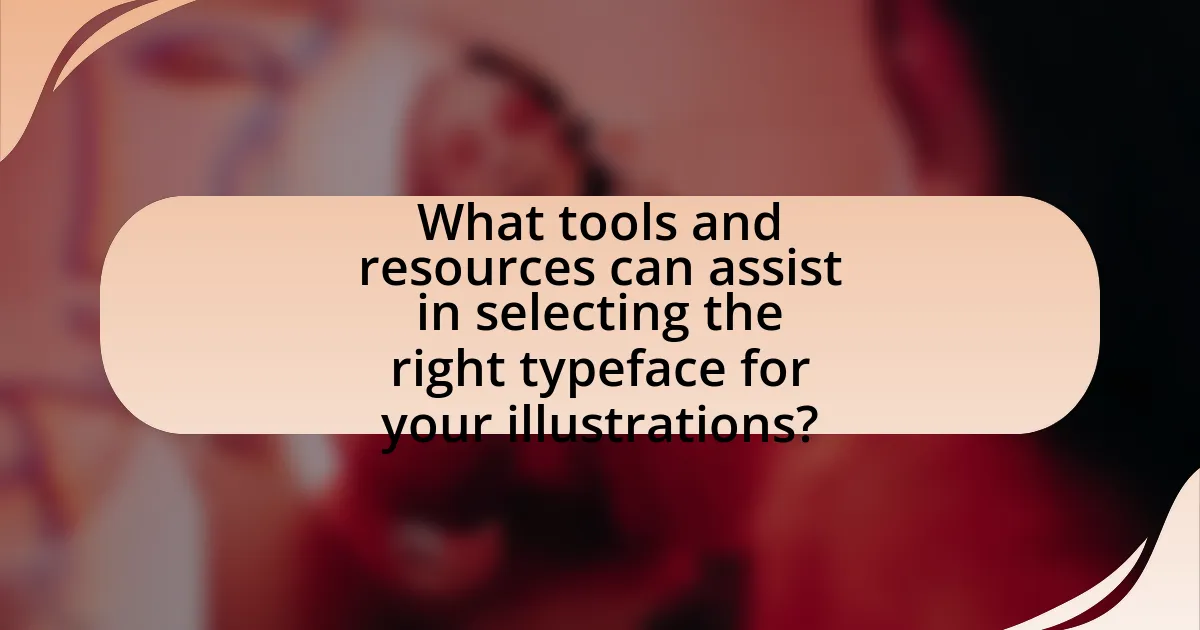
What tools and resources can assist in selecting the right typeface for your illustrations?
Tools and resources that assist in selecting the right typeface for illustrations include online typeface libraries, design software, and typography websites. Online typeface libraries like Google Fonts and Adobe Fonts provide extensive collections of fonts that can be filtered by style, popularity, and usage, making it easier to find suitable options. Design software such as Adobe Illustrator and Canva often include built-in font selection tools that allow users to preview typefaces in their specific design context. Typography websites like Typewolf and Fonts In Use offer curated lists and examples of typefaces in real-world applications, helping designers understand how different fonts perform visually. These resources collectively enhance the decision-making process by providing access to a wide range of typefaces and practical insights into their application.
What online tools are available for typeface pairing and selection?
Online tools available for typeface pairing and selection include Google Fonts, FontPair, and Typewolf. Google Fonts offers a vast library of fonts and a feature to preview combinations, making it easy to see how different typefaces work together. FontPair specializes in suggesting font pairings that complement each other, providing a user-friendly interface for designers. Typewolf curates a collection of popular typefaces and showcases real-world examples of font pairings, helping users make informed choices. These tools are widely recognized in the design community for their effectiveness in aiding typeface selection.
How can you use font pairing tools effectively?
To use font pairing tools effectively, select complementary typefaces that enhance readability and visual appeal. Start by choosing a primary font for headings and a secondary font for body text, ensuring they contrast well in style and weight. For instance, pairing a serif font with a sans-serif font often creates a balanced look. Utilize tools like Google Fonts or Adobe Fonts, which provide curated combinations and allow you to preview how different fonts work together in real-time. Research indicates that effective font pairing can improve user engagement and comprehension, as seen in studies on typography and design impact.
What are some recommended websites for exploring typefaces?
Some recommended websites for exploring typefaces include Google Fonts, Adobe Fonts, and Font Squirrel. Google Fonts offers a vast library of open-source fonts that can be easily integrated into web projects, making it a popular choice among designers. Adobe Fonts provides a wide selection of high-quality typefaces that are accessible through Adobe Creative Cloud, catering to professional designers. Font Squirrel specializes in free, commercially licensed fonts, ensuring that users can find typefaces suitable for various projects without legal concerns. These platforms are widely recognized in the design community for their extensive collections and user-friendly interfaces.
What are the best practices for testing typefaces in your illustrations?
The best practices for testing typefaces in illustrations include evaluating readability, assessing visual harmony, and conducting user feedback sessions. Readability can be tested by examining how well the typeface performs at various sizes and in different contexts, ensuring that it remains legible across different mediums. Visual harmony involves checking how the typeface complements the overall design elements of the illustration, including color schemes and imagery. User feedback sessions provide insights into audience perception and preferences, allowing for adjustments based on real-world reactions. These practices are essential for ensuring that the chosen typeface enhances the effectiveness of the illustration.
How can mockups help in evaluating typeface choices?
Mockups assist in evaluating typeface choices by providing a visual representation of how different typefaces will appear in a real-world context. This allows designers to assess readability, aesthetic appeal, and overall effectiveness in conveying the intended message. For instance, a mockup can showcase how a typeface interacts with other design elements, such as images and colors, enabling a more informed decision based on visual harmony and functionality. By simulating the final product, mockups help identify potential issues with legibility or style that may not be apparent in isolated type samples, thus enhancing the selection process for effective typography in illustrations.
What criteria should you use to assess typeface effectiveness in your illustrations?
To assess typeface effectiveness in illustrations, consider legibility, appropriateness, and visual harmony. Legibility ensures that the typeface is easily readable at various sizes and distances, which is crucial for effective communication. Appropriateness involves selecting a typeface that aligns with the theme and message of the illustration; for example, a playful typeface may suit a children’s book, while a serif typeface may be more fitting for a formal publication. Visual harmony refers to how well the typeface integrates with other design elements, such as color and imagery, creating a cohesive look. Research indicates that typefaces can influence perception and emotional response, underscoring the importance of these criteria in achieving effective visual communication.
What tips can help you choose the right typeface for your illustrations?
To choose the right typeface for your illustrations, consider the tone and message of your artwork. The typeface should complement the visual elements and enhance the overall communication. For instance, a playful illustration may benefit from a whimsical font, while a serious piece might require a more traditional typeface. Additionally, ensure readability by selecting a font that is clear and legible at various sizes. Research indicates that typefaces like Helvetica and Arial are widely recognized for their clarity, making them suitable for diverse applications. Ultimately, the chosen typeface should align with the illustration’s purpose and audience, ensuring effective visual communication.
How can you create a cohesive visual style with your typeface choices?
To create a cohesive visual style with your typeface choices, select typefaces that share similar characteristics, such as weight, contrast, and mood. For instance, using a sans-serif typeface for headings and a complementary serif typeface for body text can establish a harmonious relationship, enhancing readability and visual appeal. Research indicates that consistent typeface usage can improve user experience and brand recognition, as seen in studies by the Nielsen Norman Group, which emphasize the importance of visual consistency in design.
What are the key takeaways for selecting typefaces that enhance your illustrations?
Selecting typefaces that enhance illustrations involves prioritizing readability, ensuring stylistic harmony, and considering the emotional tone of the design. Readability is crucial; typefaces should be legible at various sizes and distances to maintain clarity. Stylistic harmony means choosing typefaces that complement the visual elements of the illustration, creating a cohesive look. Additionally, the emotional tone of the typeface should align with the message of the illustration; for example, a playful illustration may benefit from a whimsical typeface, while a serious topic may require a more formal font. These principles are supported by design theories that emphasize the importance of visual hierarchy and the psychological impact of typography on viewer perception.
